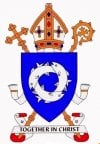North Pole Mission, 1855-1869, Places
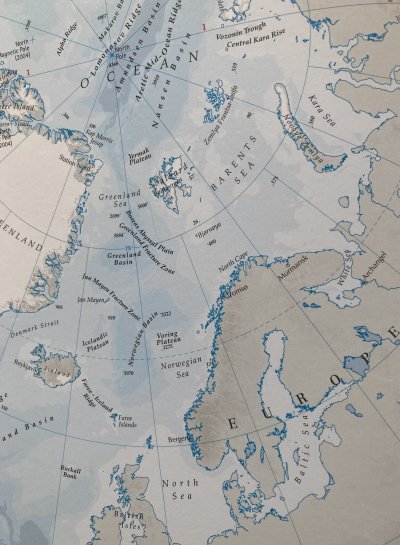
ARCTIC NORWAY – FAROES – ORKNEY AND SHETLAND – CAITHNESS – ICELAND
The headquarters of the North Pole Mission were in Alta (Norway) 1855-1860; Wick (Scotland) 1860-1866; Copenhagen (Denmark) 1866-1869.
The NORTH POLE MISSION was established by Pope Pius IX on 8th December 1855, the first anniversary of the proclamation of the doctrine of the Immaculate Conception. It was placed under the jurisdiction of Propaganda Fidei in Rome.
The original intention appears to have been a mission to all lands north of 64 degrees latitude in the Arctic Circle. It was to be an international Prefecture Apostolic with its base at Alta on the north Norwegian Coast. The founding missionaries had hoped to expand westwards to Greenland and Hudson Bay in North America but resources were always sparse and the North Pole Mission was confined to Arctic Norway (1855), Iceland (1857), the Faroe Islands (1857) and Orkney, Shetland and Caithness in Northern Scotland (1860).
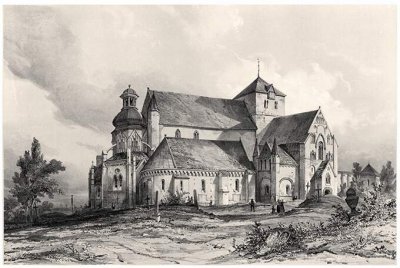
The choice of mission stations was partly guided by practical concerns, partly by a desire to reflect the territory of the medieval Norwegian diocese of NIDAROS (modern Trondheim). The medieval see of Nidaros, according to a twelfth century document, had metropolitan jurisdiction over the Norwegian churches of Nidaros, Bergen, Stavanger, Oslo and Hamar. The bishop’s authority also extended to Norwegian territories overseas: Orkney and Shetland; the Western Isles and the Isle of Man; the Faroes; Holar (Iceland), Skalholt (Iceland); and Gandar (Greenland).
The North Pole Mission comprised six principal stations, served by eight priests, listed in 1865 as follows: 1. Altengaard, Norway; 2. Tromso, Norway; 3. Thorshavn, Faroe Islands; 4. Reykjavik, Iceland; 5. Shetland, Orkney and Caithness, Scotland; 6. Lerwick, Shetland Islands.
THE MISSION TO ARCTIC NORWAY (1856-1869)
Norway had become at least nominally Christian in the reign of King Olaf Tryggvason in the late 10th Century and had belonged to the Catholic Church until the 16th Century Protestant Reformation. From that date on the country was Lutheran.
On 16th July 1845, the King of Norway-Denmark for the first time permitted religious dissenters and other churches could move into his kingdom. Toleration did not extend to Jews, Jesuits, or orders of monks.
Eleven years after this royal decree, Etienne Djunkowsky, Prefect Apostolic of the newly created North Pole Mission established his base at the fishing village of Alta (70 degrees north). It was near the Russian border and, despite its remote location well within the Arctic Circle, many ships passed through. Djunkowsky reported to the Roman authorities at Propaganda Fidei that every year 800 Russian vessels arrived at the port, representing 7,000 -10,000 men putting in for commerce. The Lapland mission had potential for access to the Russian empire.
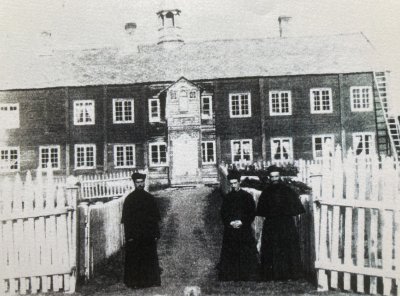
On 29th July 1856, Djunkowsky established a missionary college at Alta, also known as Altengaard. He had purchased a magnificent estate which had previously been the residence of the Governor General of Lapland. The house had a beautiful setting, with fields and meadows, cattle and timber, in striking contrast to the surrounding area, and the area enjoyed a mild climate. The chapel was in a room on the first floor and the missionaries also had a library of several hundred volumes. The purchase was achieved with the support of Belgian benefactors. The photograph was taken in the 1880s but shows the building adapted as the first mission headquarters, seminary and residence. There were at least four missionaries present here in 1856: the Apostolic Prefect, Etienne Djunkowsky; his Vicar General, Abbé Bernard Bernard, Fr Georg Bauer and the Icelandic layman, Dr Ólafur Gunlögssen.
By 1859 there was a mission at Tromso, the capital of Norwegian Lapland. Djunkowsky intended this to be the centre for the arctic mission since steamships put in at the port and there was easy communication with Iceland and the Faroes. The Gothic-style chapel in Tromso was built in 1860 in the countryside just outside the town, there was also a Catholic cemetery. This was the most successful of the Lapland missions in terms of conversions. It had gone in a short time from being a town with no Catholics to a fair sized parish.
From Tromso the mission was also extended to the only other substantial town in Lapland, Hammerfest. Here there was only a house and land set aside for a future church. Abbé Boller was described as the superior of the Lapland Mission in 1859, when there were five stations: in addition to the three already mentioned, he had charge of Vina in the mountains of Lapland and Gjesvar, situated near North Cape, beyond which there was no habitation. An additional station at Namsen was confided to the North Pole Mission, before October 1860, by Mgr. Studach, Vicar Apostolic of Sweden and Norway.
After the ending of the North Pole Mission in 1869, Monsignor Bernard Bernard became the Apostolic Prefect of a newly defined Norwegian prefecture. In 1876 he approached the Missionaries of Our Lady of La Salette, then still a strictly diocesan congregation in the diocese of Grenoble, to provide clergy for Norway. After some initial hesitation, they agreed and on 6th March 1879 the Sacred Congregation for the Propagation of the Faith confided the Norwegian Mission to the Missionaries of Our Lady of La Salette for a trial period of ten years. They withdrew from Norway in 1892.
THE MISSION TO ICELAND (1857-75).
Djunkowsky sent Abbé Bernard Bernard to Iceland in 1856. Djunkowsky arrived in 1857 to establish the mission and the following spring Fr. Jean-Baptist Baudoin was sent as assistant priest. Bernard Bernard is listed in 1859 as Superior in Iceland. There were anti-Catholic laws in place in Iceland and the missionaries were only allowed to serve the pastoral needs of Catholic fishermen and whalers, mainly from France and Belgium. Between 240 and 300 boats put in to Iceland ports. At the beginning they were very short of resources and the two priests had to share a single room, rented from a Danish merchant, where they also celebrated Mass. This lack of space made it very difficult for the missionaries to gather the people for instruction in the faith. Soon after arrival in Iceland, Bernard made a reconnaissance journey to the north of the country.
The first base was at Seydisfjordur on the east coast. Bernard rented a room where the French and Belgian fishermen could worship. In 1859 he moved the mission to Grundarfjordur and then, in 1860, to Reykjavik where he bought a property at Landakot. He built a modest wooden chapel here in 1864.
The Icelandic authorities blocked Abbé Bernard’s attempts to establish a school and hospital in Reykjavik and these were not finally built until the 20th century, although in July 1859 the missionaries received permission to open a hospital in Seydisfjordur for the benefit of Catholic fishermen. The Icelandic mission did not take root. Bernard left Iceland in 1862, and was replaced by E.M. Dekiere in 1864 who worked in Iceland until his transfer to Norway in 1867. Baudouin persevered until 1875.
THE MISSION TO THE FAROE ISLANDS (1858-72)
Like Norway, the Faroes had been closed to Catholic missions before the royal decree of 1845. The first missionary here was the German priest Georg Bauer. He initially met with hostility and suspicion. Bauer arrived from Norway in 1857 with an Italian assistant-priest, Luigi Mossa, who does not appear to have stayed long. The Faroes were then served by steam ships twice a month between March and November, linking the islands to Scotland, Denmark and Iceland. At the end of 1858 Bauer was joined by a young newly-ordained priest from Belgium, Theophilus Verstraeten, who was transferred to Shetland in October 1860. A house was purchased this year at Raettara in the capital Thorshavn and a church was opened in July 1859. Seventy people participated in the first Mass there. The congregation was mainly made up of Belgian and French fishermen. Fr Bauer remained twelve years in the Faroes until 1872. For much of the time he was the sole priest in the islands and, if the Prefect Apostolic did not make a visit, needed to travel to Scotland at least once a year for confession. The mission was abandoned in 1894.
MISSION TO ORKNEY, SHETLAND AND CAITHNESS (1860-69)
Orkney and Shetland had belonged to Norway from the late 10th to mid 15th centuries. Their addition to the North Pole Mission came in 1860 after discussions with Cardinal Wiseman in London and bishops Gillis and Kyle in Scotland. Djunkowsky had realised the impracticality of Alta as the centre of the mission given that it was at the far extremity of the territory assigned him. In 1858, when negotiations to transfer the mission headquarters to Copenhagen had stalled, Djunkowsky proposed Kirkwall in Orkney as “equidistant from Rome, Iceland and Altengaard”.
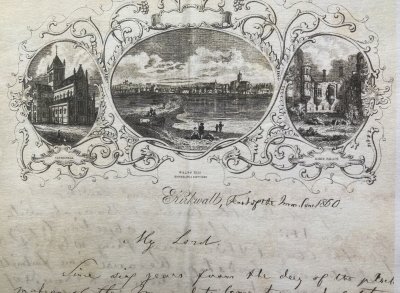
Letter of Djunkowsky to Bishop Kyle 08.12.1860 mentioning the acquisition of Orkney and Shetland. The letter heading shows the medieval Cathedral of Kirkwall and the ruined Bishop’s Palace, near which Djunkowsky had obtained lodgings.
In the end, Wick in Caithness was chosen as being a flourishing fishing port, frequented by Scandinavian fishermen. The three territories of Orkney, Shetland and Caithness were detached from the Northern District of the Scottish church and assigned to Djunkowsky as part of the North Pole Mission. This arrangement remained in place until 1869 when the North Pole Mission was broken up into national territories. The headquarters of the Mission was transferred to Copenhagen in Denmark in 1866. The chapel of St Joachim and presbytery had already been established in Wick, and were entrusted to the Mission for its use. A little before 1869, the missionaries had built a house at Wick which was intended as a school, which was to be run by religious sisters of the Faithful Companions of Jesus. The railway had not yet been constructed and transport was provided by a steamer which ran once a week in winter, and twice a week in the summer.
Djunkowsky arrived in Lerwick by sea on 30th September 1860 and established his base at the Zetland Hotel. Fr Theophilus Verstraeten was summoned to Lerwick from the Faroes to take charge of the new mission in Shetland and he would remain here – apart from short periods assisting in Orkney and Caithness – until his premature death, eleven years later, on 30th May 1871.
The first chapel in Lerwick was established in a warehouse (Clark's Lodberry) reached from Sinclair's Beach. In 1864 Fr Theophilus Verstraeten bought the Zetland Hotel building and Mass was said in an upstairs room, accessed from Queen's Lane. Shortly before his death, Fr Verstaeten had drawn up plans for a more permanent chapel in the garden of the Zetland Hotel building (77 Commercial Street) but the work was abandoned when Shetland no longer had a resident priest and the building sold.
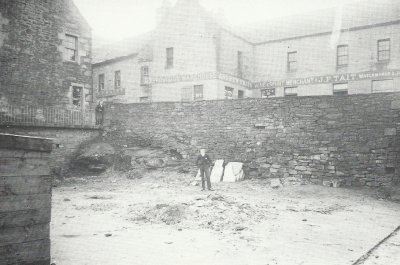
The Zetland Hotel building in 1904, taken from Sinclair's beach. The entrance to the original chapel of St Anne was just out of shot. It was reached from the beach. Fr Theophilus Verstraeten had lodgings with the Clark family 1860-64 in the building on the left of the photograph (40 & 42 Commercial Street).
Orkney had no resident priest and was served at intervals from Wick. The Prefect Apostolic, Bernard Bernard, was the sole priest in Wick, and Caithness was left without pastoral provision when Bernard was visiting the other stations of the Mission. When Bernard moved the mission headquarters to Copenhagen in 1866, he appointed J.P. Capron to Wick. Capron was later assisted by Claude Dumahut and Rev Vanwtberghe from Bruges.
COPENHAGEN, Denmark.
In 1866, Copenhagen was made the administrative centre of the North Pole Mission because of its transport links to the Faroes, Iceland and Norway. It had previously been based in Wick, Scotland. The transfer of the Prefect Apostolic to Copenhagen was approved by Propaganda Fidei at its meeting of 20th March 1866. The mission acquired a house in the Nörrebro district of Copenhagen as residence of the Prefect Apostolic, still only half paid-for in 1869, and there were plans to establish a seminary in the city. It was described in 1869 as “la Solitude”.
THE SUBSEQUENT HISTORY OF THE MISSION TERRITORIES.
After the dismantling of the North Pole Mission in 1869 the Norwegian Arctic Missions became part of the new Prefecture Apostolic of Norway.
Denmark was also established as a Prefecture Apostolic, overseeing the missions in Iceland and the Faroes.
The missions of Caithness, Orkney and Shetland were returned to the Vicar Apostolic of the Northern District of Scotland. In 1878 the hierarchy was restored and these territories became part of the Roman Catholic Diocese of Aberdeen.



